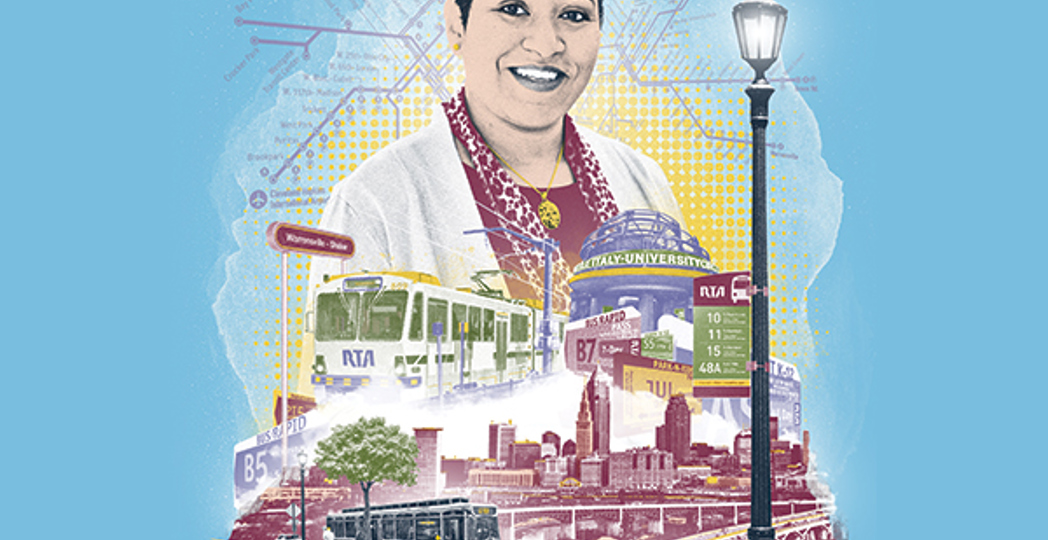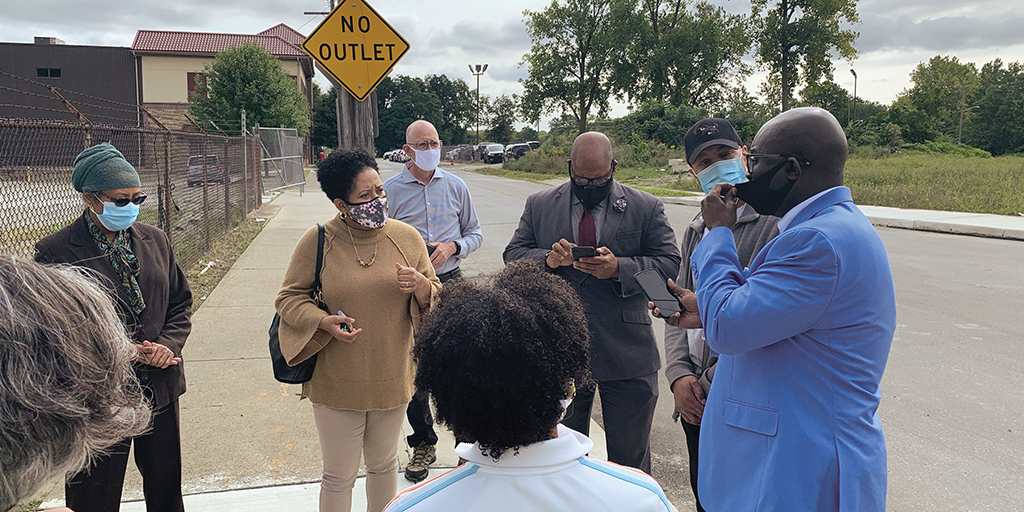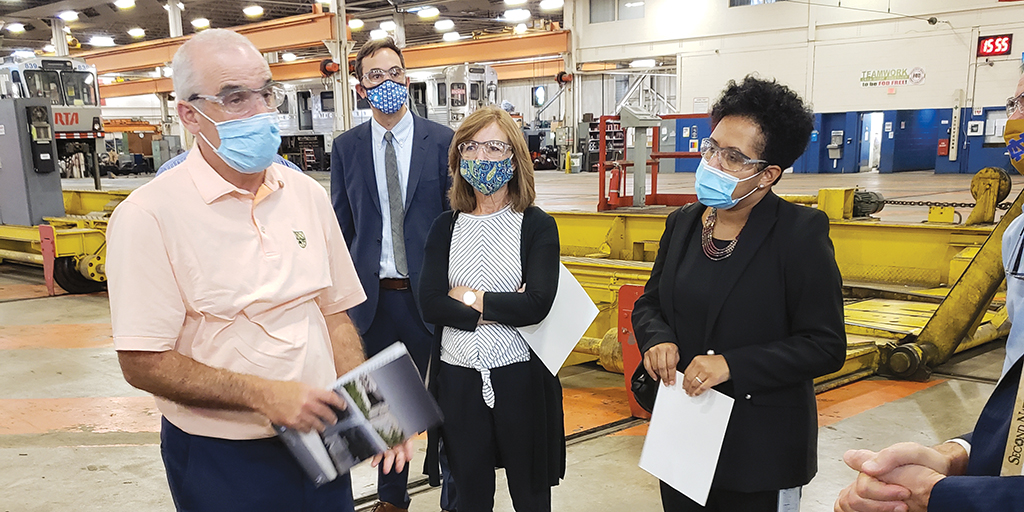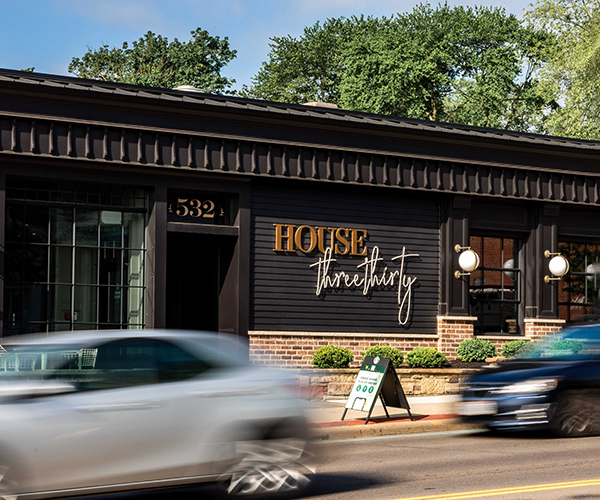India Birdsong Takes The Wheel At RTA
by Sheehan Hannan | Nov. 9, 2020 | 1:00 PM

Ryan Olbrysh, Nicki Prentler
A poster hangs on the fifth-floor conference room wall at the Greater Cleveland Regional Transit Authority’s headquarters. Emblazoned with the organization’s customary shades of red and blue, the print boasts the phrase: “To provide a safe, reliable, clean and courteous public transportation.” It’s a boring piece of office propaganda that most people walk past and dismiss.
But not for CEO and general manager India Birdsong — RTA’s future depends on selling that mission statement better.
Many Clevelanders have taken public transit granted for so long that we no longer see its specialness and importance. While you might get frustrated when the bus or train isn’t on time, you think little of it otherwise. And that is the essence of the problem that Birdsong was brought in to solve: to secure RTA’s place in sprawling Northeast Ohio, it must show Clevelanders the upside of public transit.
RTA has shrunken in the 46 years since it was founded, but it remains a vital lifeline for Clevelanders: 350 buses squeak up to 5,720 shelters and stops every day, planted on sidewalks and curbs across 59 municipalities from Euclid to Bay Village to Strongsville to Brecksville. Those buses, not to mention 85 RTA-owned bridges and 92 trains, are maintained, administered, guided and driven by 2,200 people, a workforce which makes RTA about twice the size of Bratenahl.
RTA turned to Birdsong, who started last September, after an especially rough ride for the agency. In the space of 12 herky-jerky months in 2018, RTA was T-boned by a public corruption scandal involving its board chairman, skidded through service cuts and worry over fare hikes, lost a CEO, and swerved toward and then away from proposing a tax increase. Meanwhile, riders continued to slip away. In Birdsong — RTA’s first female CEO, its first Black CEO and its first millennial CEO — RTA hoped to find a hand that would steady the wheel.
“By virtue of my hire alone, the board made a statement to the city, and said ‘Hey, we want change,’ ” Birdsong says. “ ‘We want someone a little different.’ ”
The wisdom of that choice became immediately evident when COVID-19 came along, testing Birdsong’s abilities and her agency. The pandemic put the lives of RTA’s riders and drivers and mechanics in danger and created worry around RTA’s finances. Birdsong managed RTA with a deft hand through the crisis — while also having her first child and taking maternity leave.
But now it is September and Birdsong, whose easy smile, quick wit and gregarious laugh are in no way hidden by the mask on her face, sits in that RTA conference room thinking about the mission on that poster — and how to get the organization back on track. While she’s not ready to reveal her entire plan, right now she’s focused on brainstorming ways to make riders feel comfortable. Her idea? A test ride.
“We have to bring people back to try it, and be able to exceed their expectations when they’re on it, and then recreate what their perception of our service is,” says Birdsong. “We need to get people to take a chance on it, then say, ‘Well, that was better than driving my car. Let me try another trip.’ ”
RTA needs more test rides than ever because, with each passing year, RTA’s ridership is shrinking. At its all-time peak, in 1980, it gave 129.7 million rides annually. Last year, RTA gave 32.7 million rides. The prospect of a much smaller RTA looms large, a situation that would leave thousands of Clevelanders quite literally stranded at the curb.
The causes are complicated, but the downward direction can be attributed to a combination of rising ride-sharing companies, a smaller RTA system, higher fares, suburban sprawl and a nearly impenetrable Midwestern car culture.
Of Cuyahoga County’s roughly half-million households, about 70,000 don’t have a car, even as cars are the main way that people here get to work. About 80% of the county normally commutes in their car, alone. Birdsong has to untie that knotty situation, winning back riders without other transportation options that have abandoned RTA, while also, somehow, making RTA more attractive than the leather-lined confines of a mid-sized SUV in virtually traffic-free Cleveland. Making that case will be tough. But Birdsong, who rode RTA every other day before COVID-19, thinks the time is right to start.
“Cleveland is actually in a good situation right now, because we are dealing with systems that are becoming obsolete, whether it’s technology systems, whether it’s operational systems,” says Birdsong. “We’re at a point where we’ve got to decide: Are we going to a completely new system? And we actually have the opportunity to look at those options.”
A different RTA may soon be coming down the tracks, one that could make that poster look anything but boring. “If we move quickly, and we move with intention,” Birdsong says, “yeah, we’ll be able to see those changes pretty quickly.”

India Birdsong's climb to the top chair at Ohio’s largest transit agency began in her grandmother’s basement in Chicago. She sat at a table there one day in the summer after she had returned from Temple University in 2004, and decided what she wanted to do. On the table was a book. It listed graduate school majors, and, with her mother and grandmother, she leafed through it, until the pages turned to an option that had recently caught Birdsong’s fancy.
Growing up on the near West Side of Chicago, Birdsong came from a line of teachers and lawyers and businesspeople. Her father ran his own computer shop, and she had uncles who worked in corporate law. But around that table, and in her household, the teachers were in full effect. Birdsong’s mother was a professor of Black art history at Wilberforce University. Her grandmother was a fifth grade teacher.
They taught her that an education was of nearly immeasurable value, and so, after going to public elementary schools in Chicago, Birdsong went to the Brooks School, a highly competitive boarding school in North Andover, Massachusetts, outside Boston. She was a scholarship kid, and found the verdant lakeside campus, where to this day only 26% of the students are of color, to be a foreign world. “Going through a metal detector to have to go to [public] school is very different than having a roommate that had a jet at their disposal,” Birdsong says.
For college, Birdsong returned to her city roots. She selected Temple University, right in the middle of North Philadelphia, where she studied English, minored in Spanish, and upon graduation took the LSAT with the full expectation of becoming a corporate lawyer.
The test, though, scared her off, and Birdsong took a gap year, eventually returning to Chicago. She had used public transit to get around Boston and Philadelphia and realized, in all her travels in East Coast cities, that there were many curious things about those places, like a liquor store she once saw that was right next to a church. “Who’s laying them out? Who makes those decisions?” Birdsong recalls asking herself. “And how can I get in on that?” She thought some more about it. Then, at the table in her grandma’s basement, she thumbed through the book, until it landed on urban planning.
She was admitted to a graduate program at the University of Illinois at Chicago. Afterward, she went to work for the Chicago Transit Authority. The agency was overhauling its bus routes on the South Side, and Birdsong took an outreach position running community meetings. At the meetings, her light-brown skin, curly, natural hair and Spanish fluency meant that Black and Latino residents often confused her with a neighbor, and she became accustomed to hearing emotional reactions to CTA’s changes. “If you’re depending on that bus or that train, you know, if that’s your lifeline, and a lot of times it is, it’s almost like if someone decides to key your car,” she says. “You’re going to be a little mad about that.”
She kept that experience in mind as she moved into a full-time CTA planning department job, and then swiftly up the ranks. After a few years, she made what in transit circles is considered an unexpected jump from planning into operations. She learned how to speak over the squawking radio in CTA’s cryptic numbered codes, became senior manager of the agency’s Central and West Side divisions, and handled the transit logistics of President-elect Barack Obama’s 2008 victory night event at Grant Park.
By 2015, she had been plucked out of middle management and landed in the C-suite, taking on the top operations post at the public transit agency in Nashville, Tennessee.
There, she saw firsthand the fiery politics of transit. Between 2000 and 2018, Nashville grew from 570,434 to 682,587 residents, and the transit needs of those people grew with their number. The city’s political establishment, from the mayor, Megan Barry, to the local chamber of commerce and the Nashville Predators hockey team, banded together around a massive, $8.9 billion package of transit improvements, dubbed Let’s Move Nashville. It would levy a sales tax, build train lines and expand bus service.
“A lot of people were moving there from places like California and New York, so they were expecting transit,” says Birdsong. “So, as many people were coming in, we still had to deal with the folks who kind of loved Nashville for what it was and didn’t necessarily want to see it change. We had that kind of dichotomy going on.”
By the time Let’s Move Nashville reached the voters, however, it had been fumbled. Repeatedly. Barry, the plan’s chief salesperson, resigned after a scandal involving an affair with an officer on her security detail. The high-priced public relations firm promoting the proposal lurched between narratives that never quite stuck. A competing coalition of conservative donors hired political organizers with deep ties to Nashville’s Black community, who took full advantage of the muddled messaging. Their argument: This big-time development proposal helps downtown, not your neighborhoods.
That message found purchase among concerns about gentrification in growing, left-leaning Music City. “Internally, the conversations were always great,” says Julie Timm, who was then the transit authority’s development chief, and had an office next to Birdsong. “It was externally that we had to work through challenging politics and very diverse views.”
In the end, 64% of voters cast ballots against Let’s Move Nashville. It won in millennial-heavy areas around downtown, The Tennessean reported, like where Birdsong lived near Vanderbilt University. But it lost soundly everywhere else, in majority-Black wards, and in farther-flung suburban areas. Both groups saw that they would not be the main beneficiaries of the new system, which seemed to cluster its flashiest improvements around the city core. “It wasn’t a plan that addressed working people’s needs first, or as a priority of it,” says Ashley Batchelder, an organizer for Music City Riders, a rider advocacy group.
Birdsong tried to learn from the loss. She concluded that referendums sometimes just don’t pass on the first try, and that any transit plan must meet voters where they are. “It’s really just taking a minute to listen to what they know, and translating the data into something that’s readily tangible,” says Birdsong, “so that someone can see themselves in the project, and understand and then make a decision.”

In 2016, I visited RTA’s rail yard. It is a big warehouse, down in the ravine where Kingsbury Run once flowed. Rows and rows of steel tracks ran into a massive 4-acre central building, directing the heavy, shimmering cars of the Red Line and the nimbler, gray cars of the Green and Blue lines indoors.
Inside the warehouse, I met Casey Blaze, RTA’s head of rail maintenance. He took me on a tour, showing off the trains hoisted onto stilts and lifts. He explained the mechanics’ jobs, the grinding and drilling and upholstering and replacing, the throwing of sparks and pounding of mallets.
Then he led me through a door in the back of the shop. We emerged into a darkened storage room that smelled of grease and metal. Train parts sat in organized clumps, big hunks of steel resting on the ground and the shelves. RTA’s rail cars, he explained, were the equivalent of tottering old men. It took everything in his mechanics’ power to keep them rolling. Most were manufactured in the 1970s and ’80s, and the companies that made them had stopped supporting them. This room was, in effect, a transplant unit. To fix its newer trains, RTA was taking parts from older ones. “I can’t call up a company and say, ‘Send me over a gear box on an assembly,’ ” Blaze later told me. “They’ll say ‘Huh? We haven’t made those since 1993.’ ”
What was happening with the trains could have been a metaphor for the entire agency. The trains were a callback to better times, to when transit in the Sixth City was as grand as the city itself. But as the metro area sprawled outward, RTA did not expand along with it. Even today, it lacks the funds and reach to get to the riders in suburban counties that it needs to thrive. If it does not reach them, and capture their precious tax dollars, it will get slowly smaller in unison with Cuyahoga County, which has lost 263,000 residents since RTA’s peak in 1980.
With the slow passage of time, more and more people who need public transit to get to a job, a doctor or their grandma’s house could be cut off, making Cleveland’s already-numerous inequities worse. “My big fear is that the system contracts so much that people will say, ‘Why bother funding it? It doesn’t go anywhere. It’s not useful,’ ” says Chris Stocking, co-founder of Clevelanders for Public Transit, a riders advocacy group.
That pattern of decline has been accelerated by circumstances outside of RTA’s control. In 2017, Ohio’s Republican-controlled state government, which was already giving just a measly 63 cents per capita to public transit, decided to exclude Medicaid-managed care organizations from the sales tax, which blasted a $20 million hole in RTA’s annual budget. Luckily for RTA, the state issued one-time payments to cover the shortfall.
But after that, RTA had to fill the $20 million annual hole on its own. To do that, as 2018 dawned, then-CEO and general manager Joe Calabrese pitched a package of service reductions and a fare increase of 25 cents. Higher fares would mean fewer people could afford them, and service cuts would mean that people had to walk farther for the bus, or wait longer for one to arrive, potentially disrupting job schedules and medical appointments. Of those options, riders lobbied hardest against the increased fares, which had already gone up from $1.25 to $2.25 per ride during the recession of 2006-2010. The fare increase was put on hold. But the service cuts went ahead. Some routes were moved, leaving riders to trudge to new stops.
Compounding the bad headlines, in March 2018, RTA board chairman George Dixon III suddenly resigned. He had been on the board for almost 30 years, most as chairman, and had failed to pay health insurance premiums for decades. The boss of bosses had in effect scammed his way into almost $1 million worth of free health care. Prosecutors brought theft in office charges against him. (He pleaded guilty and was sentenced to one year of probation this January.)
The scandal’s timing was terrible. Through the spring and summer of 2018, several members of RTA’s board and Clevelanders for Public Transit were toying with the idea of putting a tax increase on the ballot. But the scandal disrupted that effort. In the aftermath, the board voted to push Calabrese from the CEO role. With a new board president, an interim CEO and a very recent instance of public corruption in its highest ranks, the board decided not to dive into a ballot issue that would have looked about as inviting as the Cuyahoga River on fire.
That December, the search for a new CEO began.

This September, I caught the Red Line to meet with Birdsong. A very occasional transit rider, I found the Tower City station far less populated than past trips. Downtown was barren. A band played on Public Square for an audience of four. The RTA headquarters on West Sixth Street, though, buzzed with mask-sporting employees arriving from lunch, carrying brown bags through an automated temperature-taking station. Thirty-seven transit workers had been infected with COVID-19 by then, and most, luckily, had made a full recovery. Even amid the virus, RTA was as essential a service as they come, and its employees simply couldn’t stop moving. Birdsong was no exception. She sat down far on the opposite side of a large conference room table, her light-blue blouse and shirt combination playing off the color of her surgical mask.
Birdsong started her tenure with RTA on that same Tower City platform I traversed to get here. On her first day, she spent rush hour there, meeting with riders, shaking hands and hearing firsthand what needed changing.
“I wanted to be able to have that experience, to be more tactile, instead of just sit at the desk and do a video. I think people appreciate it,” Birdsong says. “And I wanted them to also see me. I’m very different than what you are probably used to, as far as the leadership of RTA. It’s no secret. Yeah, I’m not a man. Yeah, I’m not over 50.”
Birdsong paid similar visits to the RTA bus garages and the rail yard, meeting as many of RTA’s employees as she could. Her message was the same one she was sending to riders: change was coming, and she embodied it. “It was so that people could see me. Because I look like a lot of the folks that drive our buses and clean ’em up,” says Birdsong. “It was nice to be able to shake everybody’s hand and break bread with people, and really hear what the issues were.”
One of those issues was the lack of a contract with the Amalgamated Transit Union, which represents vehicle operators and mechanics. “That’s a sore spot with me,” Birdsong says, pausing to emphasize her point. “That’s one of the first things we tackled.”
The talks had dragged out for years under the previous administration, much to the chagrin of the union employees that make up the majority of RTA’s workforce. “We were two and a half years of trying to get a contract,” says William H. Nix Sr., the union president. “But she came in, and in two and a half months, we were able to get a contract.”
A number of other big efforts were supposed to really get rolling this spring, like a bus system overhaul that transit advocates had long pushed for. But COVID-19 presented a more immediate crisis.
It also brought on the first public criticisms of Birdsong’s tenure. Bus drivers and train operators were especially in danger, and RTA initially struggled to source personal protective equipment for them, drawing criticism from the union. “The way COVID-19 was hitting at that stage, it was scary, it was dangerous,” says Nix. “Our members were worried about being out there on the road.”
In response, Birdsong set up twice-weekly information sessions with the union, made sure communication blasts went out to all employees and media, set RTA’s upholsters to sewing masks and implemented daily deep cleanings. Masks were also made mandatory on RTA vehicles, plastic shields were installed and the agency was able to forgo any layoffs. “The [union] membership so far feels good, they see progress,” says Nix. “They see that she didn’t cut them, go after layoffs at the time.”
In addition to protecting her employees, Birdsong says that there was a personal dimension to her COVID-19 response. She was pregnant, and as the pandemic was getting worse, her belly was getting bigger. “Not only was I responsible for RTA, and the lives that come in here every day, I was growing a life at the same time, and I was responsible for that as well,” says Birdsong. “I took care of myself, but I had to take my own fear out of it, because I felt responsible for so much more. It was a constant reminder. Being with child through that, you don’t forget to put on a mask, you don’t forget what the risk is.”
Birdsong’s son arrived in May, and she left for maternity leave at her home in Cleveland Heights, which she shares with her husband and her bulldog Sebastian. She returned in August, just as the long-term effects of the coronavirus downturn became evident.
After the chaos of 2018, 2019 was a budgetary respite, driven by modest growth in sales tax revenue. But 2020 has been a financial hurricane. Ridership has been hurled groundward, with passenger fare revenue projected to decline by 45% this year. Sales tax receipts are a site of devastation too, projected to decline by nearly 10%, a significant hit to RTA’s largest lifeline. The lean times are expected to continue into 2021 and 2022. RTA projects that income from passenger fares should bounce back over the next two years, though not quite to pre-COVID-19 levels. But sales tax revenue is expected to inch back up by only 1% next year, and only 5% in 2022.
The agency, luckily, received $112 million from the CARES Act, which it has used to fill in the budgetary gaps. It temporarily cut service as ridership numbers plummeted early this year, but has now returned to 93% of its pre-COVID-19 capacity. Only a few routes were cut, and those were the least frequently used, like the downtown trolleys. “At this point, our calculations show that we should be able to get through the end of the year without any layoffs,” says Birdsong. “I’m very proud to say that.”
What happens when that money runs out, though, is anyone’s guess. The only sure thing is that RTA’s reliance on the sales tax, which makes up about 70% of its revenue in an average year, straps it to the engine of the economy. A roaring recovery helps RTA. A slow one hurts it. Neither scenario, though, does anything to stop the long-term ridership declines that still fuel worry over RTA’s direction. If anything, the coronavirus has forced the issue: While RTA manages through the present crisis, it, and Birdsong, must also think about its future.
Birdsong's problem is simple: Clevelanders love their cars.
We take a lot of pride in the fact that we make them here, or at least the steel and parts that go into them. We live in a region in which car ownership is assumed, however unfairly, to be the default — only 4.6% of people in Cuyahoga County use public transit to get to work, and the average commute time is less than 25 minutes. That car-centrism, egged on by near-constant highway development, has encouraged Northeast Ohio’s job centers to sprawl beyond the area that RTA is built to service, cutting off many people from a path toward a better future.
“The service is needed in those areas [like Lorain] to connect to growing job areas, or health care. Look at the closing of Lakewood Hospital, and moving it to Avon. There’s no transit there,” says Stocking, who rides RTA to house visits for his job as a diabetes educator. “We need some kind of a vision that’s going to actually serve people, and get them where they need to go beyond just the Cuyahoga County line.”
Planners have dreamed of that kind of thing for decades. RTA was originally conceived as a five-county system, before Cleveland’s political dysfunction restricted it to Cuyahoga County. A regional system was also part of the 2014 Vibrant NEO 2040 plan.
A regional system does, indeed, still capture the imagination. Tax revenue from exurban counties would shore up RTA’s finances. But more importantly, a system that could link, say, someone living in Glenville to a manufacturing job in Elyria via bus or train would open up opportunities, bring back riders and boost the economy. In addition to that, a regional system would bring with it tons of everyday fun: imagine enjoying lunch in quaint downtown Medina or browsing an exhibit at the Akron Art Museum without the mind-numbing hour or more drive, there and back, on the freeway.
Birdsong learned hard lessons from Nashville, and isn’t ready to talk about whether RTA will eventually propose a regional system, or even a new tax referendum in only Cuyahoga County. But she does say the prospect of regional transit sounds interesting. “I think it’s possible,” Birdsong says. “If we were to move down that road though, we’d have to talk about funding tied to that sort of concept.”
Therein lies Birdsong’s greatest challenge. Any idea for a revamped RTA will bring with it a need for more money, which means the public narrative around public transit in Cleveland must first shift away from crisis and catastrophe and decline, and toward showing the opportunities that transit can open up for the average Clevelander. Right now, Birdsong says, she is focusing on small but significant ways to do that by improving RTA’s customer service.
During her introductory tour of the paratransit garage last year, for instance, Birdsong noticed that paratransit riders were often waiting far too long to schedule a ride, or when a van showed up, it took a long time for it to get passengers to their destination. Right there, in the call center, she launched a plan to overhaul the call system software, and riders are now being scheduled and getting where they need to go faster.
“Traditional public transit is sometimes behind the eight ball when it comes to technology and overhauling the process,” says Birdsong. “That’s what I’d like to hone in on in the next few years, to make our product even more improved, so when people actually hop on it they have a totally different experience than they did before, and there’s no denying the difference.”
The ultimate goal, Birdsong says, is for Clevelanders of all stripes to come to see themselves as possible RTA riders. “We have to make sure we serve the neighborhoods, and not just the central business district. We have to be able to serve the areas where you don’t just see the homeless person riding, you’ve also got to see the business person,” she says. “It’s going to be a slow process.”
RTA recently completed five “pillar studies,” which looked at RTA’s economic impact, fare structure, finances, rail car issues and a system redesign. RTA and Birdsong are pulling them together into a 10-year strategic plan, which she says will put RTA’s operational house in order so that it can consider more strategic goals.
In September, RTA also decreased the price of an all-day pass from $5.50 to $5, a decision lauded by riders’ advocates, and has continued its long quest to upgrade the trains, reaching $132.6 million of the $300 million total it needs.
Even with all those changes, however, Birdsong confesses that transit is still not top of mind in Cleveland. But she’s working hard to get it there.
“I have to make it function to the point where it’s kind of like in the beginning, when I was living in Chicago. It didn’t make sense for me to hop in my car. It’s kind of like, ‘Why aren’t you on the bus or train?’ ” says Birdsong. “That’s the kind of shift that I have to make sure that we do.”
For more updates about Cleveland, sign up for our Cleveland Magazine Daily newsletter, delivered to your inbox six times a week.
Cleveland Magazine is also available in print, publishing 12 times a year with immersive features, helpful guides and beautiful photography and design.
Trending
-
1
-
2
-
3
-
4
-
5










